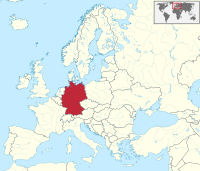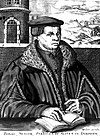
Back Portal:Dytschland ALS بوابة:ألمانيا Arabic Portal:Almaniya Azerbaijani Портал:Германия Bulgarian প্রবেশদ্বার:জার্মানি Bengali/Bangla Porched:Alamagn Breton دەروازە:ئەڵمانیا CKB Portál:Německo Czech Portal:Tyskland Danish Portal:Deutschland German
Welcome to the Germany Portal!
Willkommen im Deutschland-Portal!

|

|

| |
Germany (German: Deutschland), officially the Federal Republic of Germany, is a country in Central and Western Europe, lying between the Baltic and North Seas to the north and the Alps to the south. It borders Denmark to the north, Poland and the Czech Republic to the east, Austria and Switzerland to the south, France to the southwest, and Luxembourg, Belgium and the Netherlands to the west.
Germany includes 16 constituent states, covers an area of 357,578 square kilometres (138,062 sq mi) and has a largely temperate seasonal climate. With 83 million inhabitants, it is the second most populous state of Europe after Russia, the most populous state lying entirely in Europe, as well as the most populous member state of the European Union. Germany is a very decentralized country. Its capital and largest metropolis is Berlin, while Frankfurt serves as its financial capital and has the country's busiest airport.
In 1871, Germany became a nation-state when most of the German states unified into the Prussian-dominated German Empire. After World War I and the Revolution of 1918–19, the empire was replaced by the parliamentary Weimar Republic. The Nazi seizure of power in 1933 led to World War II, and the Holocaust. After the end of World War II in Europe and a period of Allied occupation, two new German states were founded: West Germany, formed from the American, British, and French occupation zones, and East Germany, formed from the western part of the Soviet occupation zone, reduced by the newly established Oder-Neisse line. Following the Revolutions of 1989 that ended communist rule in Central and Eastern Europe, the country was reunified on 3 October 1990.
Today, Germany is a federal parliamentary republic led by a chancellor. It is a great power with a strong economy. The Federal Republic of Germany was a founding member of the European Economic Community in 1957 and the European Union in 1993. Read more...
Selected article

Wings of Desire (German: Der Himmel über Berlin, pronounced [deːɐ̯ ˈhɪml̩ ˈʔyːbɐ bɛɐ̯ˈliːn] ; lit. 'The Heaven/Sky over Berlin') is a 1987 romantic fantasy film written by Wim Wenders, Peter Handke and Richard Reitinger, and directed by Wenders. The film is about invisible, immortal angels who populate Berlin and listen to the thoughts of its human inhabitants, comforting the distressed. Even though the city is densely populated, many of the people are isolated or estranged from their loved ones. One of the angels, played by Bruno Ganz, falls in love with a beautiful, lonely trapeze artist, played by Solveig Dommartin. The angel chooses to become mortal so that he can experience human sensory pleasures, ranging from enjoying food to touching a loved one, and so that he can discover human love with the trapeze artist.
Inspired by art depicting angels visible around West Berlin, at the time encircled by the Berlin Wall, Wenders and author Peter Handke conceived of the story and continued to develop the screenplay throughout the French and German co-production. The film was shot by Henri Alekan in both colour and a sepia-toned black-and-white, the latter being used to represent the world as seen by the angels. The cast includes Otto Sander, Curt Bois and Peter Falk.
For Wings of Desire, Wenders won awards for Best Director at both the Cannes Film Festival and European Film Awards. The film was a critical and financial success, and academics have interpreted it as a statement of the importance of cinema, libraries, the circus, or German unity, containing New Age, religious, secular or other themes.
It was followed by a sequel, Faraway, So Close!, released in 1993. City of Angels, a U.S. remake, was released in 1998. In 1990, numerous critics named Wings of Desire as one of the best films of the 1980s. (Full article...)
Selected picture
Related portals
- Parent portals
- Regional
- History
 Holy Roman Empire (900–1806)
Holy Roman Empire (900–1806) East Germany (1949–1990)
East Germany (1949–1990)
- Neighbouring countries
Anniversaries for May 27

- 1525 – Death of Thomas Müntzer, rebel leader during the German Peasants' War
- 1576 – Birth of scholar Caspar Schoppe
- 1676 – Death of hymn writer Paul Gerhardt
- 1756 – Birth of King Maximilian I Joseph of Bavaria
- 1928 – Death of mathematician Arthur Moritz Schoenflies
Did you know...
- ... that the Lutheran St. Trinitatis in Wolfenbüttel, consecrated in 1719, is a Baroque church with a facade recalling that of a palace?
- ... that Romani Holocaust survivor Philomena Franz wrote about her deportation to Auschwitz, internment in Ravensbrück, escape from a camp near Wittenberge, and concealment by a farmer?
- ... that baritone Liviu Holender chose lieder by five composers whose music was banned by the Nazis—Schreker, Zemlinsky, Mahler, Korngold and Schönberg—for a recital at the Oper Frankfurt?
- ... that ancient humans cared for a 14,000-year-old puppy?
- ... that a reviewer described the approach of soprano Magdalena Hinterdobler to her role as Grete in Zemlinsky's Der Traumgörge as "bold" and "sassy"?
- ... that Thomas Mann insisted on omitting a passage on homoeroticism in the English translation of his work "On the German Republic"?
- ... that Heike Heubach became the first deaf member of the German Bundestag?
- ... that Oksana Lyniv founded the Youth Symphony Orchestra of Ukraine in 2016 and conducted them in thirty concerts across ten music festivals in 2022?
Selected cuisines, dishes and foods

Schweinshaxe (German pronunciation: [ˈʃvaɪns.haksə] ), in German cuisine, is a roasted ham hock (or pork knuckle). The ham hock is the end of the pig's leg, just above the ankle and below the meaty ham portion. It is especially popular in Bavaria as Schweinshaxn [ˈʃvaɪns.haksn̩] or Sauhax(n) [ˈsaohaks(n̩)]. A variation of this dish is known in parts of Germany as Eisbein, in which the ham hock is pickled and usually slightly boiled.
Schweinshaxe is one of the formerly typical peasant foods, in which recipes were composed to make inexpensive and tough cuts of meat more palatable (see, for beef, the popular Sauerbraten). Such inexpensive cuts usually require long periods of preparation. The meat is sometimes marinated for days, and in the case of big cuts up to a week. The Schweinshaxe is then roasted at low temperatures, typically—depending on size—for two to three hours. (Full article...)Topics
Categories
Things you can do

A list of articles needing cleanup associated with this project is available. See also the tool's wiki page and the index of WikiProjects.
Here are some tasks you can do. Please remove completed tasks from the list.
- Requests: Columbiahalle, German Archaeological Institute at Rome, Deutsche Familienversicherung, Dietlof von Arnim-Boitzenburg, Hennes Bender, Georg Bernhard (1875–1944), Eduard Georg von Bethusy-Huc, Rolf Brandt (1886–1953), Jan Philipp Burgard, Georg Arbogast von und zu Franckenstein, Ferdinand Heribert von Galen, Herbert Helmrich, Monty Jacobs (1875–1945), Hans Katzer, Siegfried Kauder, Heide Keller, Matze Knop, Isidor Levy (1852–1929), Markus Löning, Anke Plättner, Hans Heinrich X. Fürst von Pless, Gerd Poppe, Victor-Emanuel Preusker, Hans Sauer (inventor), Franz August Schenk von Stauffenberg, Paul Schlesinger (1878-1928),Oscar Schneider, Hajo Schumacher, Otto Theodor von Seydewitz, Dorothea Siems, Werner Sonne, Anton Stark, Udo zu Stolberg-Wernigerode, Christoph Strässer, Torsten Sträter, Joseph von Utzschneider, Jürgen Wieshoff, Hans Wilhelmi,
- Unreferenced: Unreferenced BLPs, Bundesautobahn 93, Benjamin Trinks, Steeler (German band), Amelie Beese, Zoologisches Museum in Kiel, Emil Krebs, Prussian semaphore system, Partenstein, Peter Krieg, Porsche 597, Christa Bauch, Curt Cress, Stefan Beuse
- Cleanup: 53541 issues in total as of 2024-03-03
- Translate: Articles needing translation from German Wikipedia
- Stubs: Albersdorf, Thuringia, Ingo Friedrich, Berndt Seite, Federal Social Court; 107 articles in Category:German MEP stubs
- Update: Deutsches Wörterbuch
- Portal maintenance: Update News, Did you know, announcements and the todo list
- Orphans:
Orphaned articles in Germany

- Photo: Take/Add requested photographs
- Expression error: Unrecognized punctuation character ",".
Associated Wikimedia
The following Wikimedia Foundation sister projects provide more on this subject:
-
Commons
Free media repository -
Wikibooks
Free textbooks and manuals -
Wikidata
Free knowledge base -
Wikinews
Free-content news -
Wikiquote
Collection of quotations -
Wikisource
Free-content library -
Wikiversity
Free learning tools -
Wikivoyage
Free travel guide -
Wiktionary
Dictionary and thesaurus
© MMXXIII Rich X Search. We shall prevail. All rights reserved. Rich X Search
![Image 1 Saar river at Mettlach Saarschleife Credit: Wolfgang Staudt] The Saar loop (Saarschleife) at Mettlach](http://upload.wikimedia.org/wikipedia/en/d/d2/Blank.png)












































